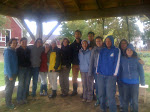Nate's morning session was on the soils of Maggie's Farm. He helped clarify the distinction between amendments--materials that are added to the soil to make up for mineral or organic deficiencies--and fertilizers--materials added to aid the growth of the plants. Of course, everything added to the soil helps the plants to grow. We talked about the soil tests we had submitted earlier with Carlen and how the less-than-optimal levels of phosphorus and potassium are dealt with over time, gradually by adding the minerals. Nitrogen, in Nate's words, is more of an "annual" in that it is checked regularly and dealt with each season. We also discussed the cation exchange ratio at length. After I finish my readings, I'll try to explain it here in the future. Understanding how soils interact with plants to create food is very important.
Equally important is understanding how animals can take grass and turn it into food! We had the sad opportunity to look in a sheep's stomach today as our lamb Rudy passed away last night. His little body had no fat on it as he had always been sickly and had been infested with worm. Our vet Dr. Ledoux told us how this time of year --when the first hard frosts hit--is typical for the sickly ruminants to die.
Ruminant animals (cows, goats, sheep, deer, moose) have one stomach that has four different parts. The first part of the stomach is the reticulum--a pouch where the food first goes to. It can be pulled right back up into the animal's mouth so he can chew it further--chewing the cud. The rumen is the "fermentation vat" of the stomach where well-chewed cud stews with small organisms--bacteria and protozoa--breaking down the grasses even further. The cud can come from here, too. The omasum is the third section of the stomach and aids in the absorption of water. Wikipedia tells me that this multi-folded section can shoot undigested chunks back into the rumen for more fermentation and break-down. The last section of the stomach is called the abomasum and this is similar to our simple human stomach where the contents are further broken down by enzymes and acids.
After looking at the lamb's stomach, we went to look at our cow, Pride. First, we listened to her digestion process and our vet showed us what to look for if she had distress in her rumen. Cows, and other ruminants, are not built to eat grain---especially corn--as their digestive tract. If you eat beef from the typical American sources, you are eating meat from an animal who lived in pain from constant stomachs-ache and who needed regular antibiotics to fight the infections caused by a mis-used digestive system. I was trying not to get preachy but I can't hold back: these animals evolved to do a wonderful thing, eating grass and turning it into delicious milk and meat. When they are fed things besides grass, their bodies aren't healthy and therefore cannot be healthy for us to eat. If we are going to eat meat, let's eat meat from animals who were raised on practices that respect their bodies.
Enough of that.
 |
| Stomach pump |
 |
| Brian, delivering a pill |
 |
| An IV into the jugular... |
 |
| Cross-section of a cow hoof |




No comments:
Post a Comment